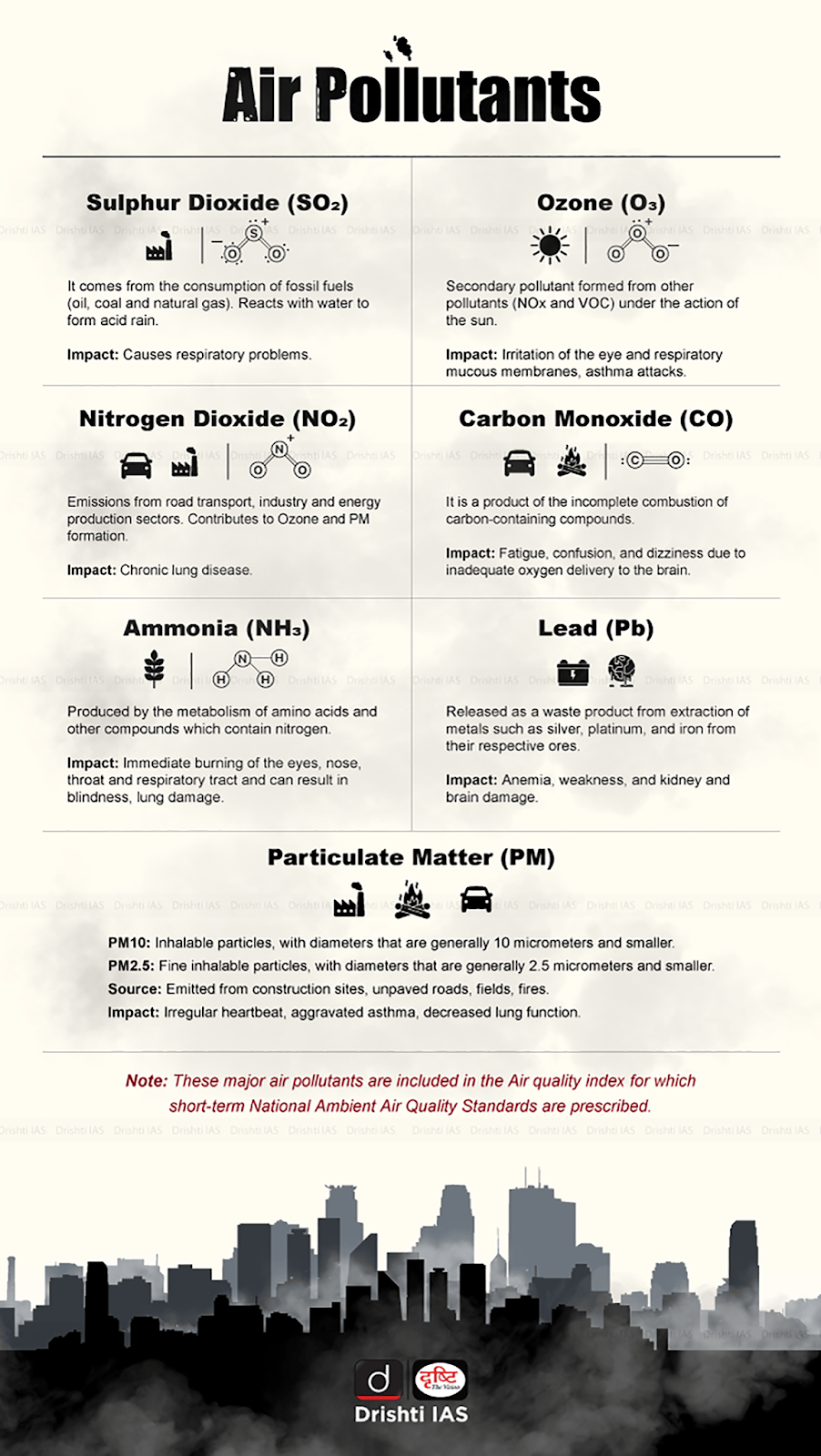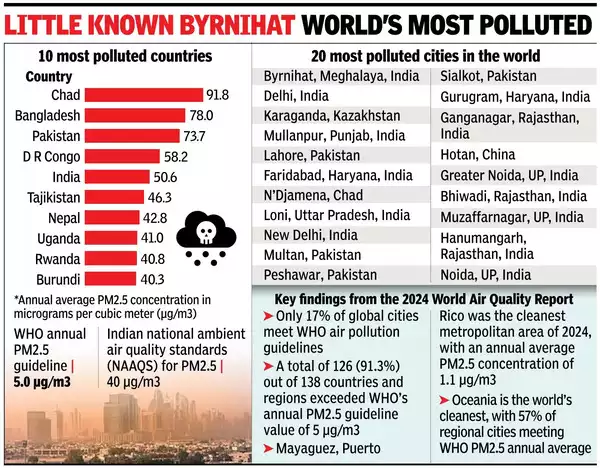India's Air Pollution Crisis | 03 Apr 2025
For Prelims: Air Quality Index (AQI), Environmental Protection Agency (EPA), PM 10, PM 2.5, Ozone (O3), Ammonia (NH3), Lead (Pb), Graded Response Action Plan, Commission for Air Quality Management (CAQM).
For Mains: Challenges posed by air pollution and ways to tackle them.
Why in News?
Air pollution in India has escalated into a persistent public health crisis, impacting millions of lives annually. It is not merely an environmental issue but a multi-faceted challenge affecting health, economy, and development.
Air Pollution
- Air pollution is the contamination of air by chemical, physical, or biological agents that alter its natural composition.
- Major sources include combustion, vehicles, industries, and fires.
- Air pollutants like PM, CO, O₃, NO₂, and SO₂ cause respiratory diseases and high mortality.
What is the State and Impact of Air Pollution in India?
- Air Pollution in India: According to the World Air Quality Report 2024 by IQAir, India is the 5th most polluted country, with an average PM2.5 level of 50.6 µg/m³, 10 times the WHO safe limit (5 µg/m³).
- Delhi remains the most polluted capital, while Byrnihat (Assam-Meghalaya border) is the world's most polluted city.
- India dominates the global pollution list, with 6 of the top 10 and 13 of the top 20 most polluted cities.
- Globally, WHO reports that 99% of the population breathes polluted air, with low- and middle-income countries most affected.
- Impact of Air Pollution:
- Health Impact: In 2021, air pollution caused 8.1 million deaths globally, with India (2.1 million) and China (2.3 million) being the worst affected (State of Global Air Report 2024).
- Health impacts include respiratory infections, lung diseases, chronic obstructive pulmonary disease (COPD), asthma, cardiac arrest, and gastrointestinal issues.
- Economic Loss: Air pollution lowers GDP growth by reducing productivity, lowering consumer activity, increasing health costs, and decreasing asset efficiency.
- Reduced Solar Efficiency: Air pollution reduces solar power efficiency by blocking radiation, while rising temperatures lower photovoltaic performance.
- By 2041-2050, India's solar panel efficiency may drop by 2.3%, causing an annual loss of at least 840 GWh of electricity.
- Environmental Degradation: Air pollution accelerates climate change by increasing greenhouse gases, degrades ecosystems through acid rain and toxin buildup, and threatens biodiversity.
- It weakens plants by excess nitrogen deposition and reduces crop yields by impairing photosynthesis due to ozone pollution.
- Health Impact: In 2021, air pollution caused 8.1 million deaths globally, with India (2.1 million) and China (2.3 million) being the worst affected (State of Global Air Report 2024).
What are the Causes of Air Pollution?Click Here to Read: Causes of Air Pollution |
What Measures Have Been Taken to Control Air Pollution?
- National Clean Air Programme (NCAP)
- System of Air Quality and Weather Forecasting and Research (SAFAR) Portal
- Graded Response Action Plan (for Delhi)
- For Reducing Vehicular Pollution:
- Pradhan Mantri Ujjwala Yojana (PMUY)
- WHO’s 4 Pillar Strategy: WHO adopted a resolution in 2015 to address the adverse health effects of air pollution adopting a 4 Pillar Strategy. Those 4 pillars are:
- Expanding the knowledge base
- Monitoring and reporting
- Global leadership and coordination
- Institutional capacity strengthening
What are the Challenges in Combating Air Pollution in India?
- Diverse Sources: Air pollution arises from industries, vehicles, biomass burning, construction, and seasonal factors like stubble burning, with rural and urban areas facing distinct challenges.
- Weak Monitoring and Policy Gaps: India faces weak air quality monitoring and policy gaps.
- While BS-VI norms and PMUY encourage cleaner fuels, enforcement is lacking.
- FAME's push for electric vehicles struggles due to a shortage of charging and battery swapping stations.
- Financial & Technological Constraints: Limited funding, outdated pollution control technologies, and underutilization of resources are slowing progress.
- NCAP aims for a 40% PM2.5 reduction by 2026 but faces challenges in implementation and funding, with a meagre budget (less than 1% of China’s air pollution control expenditure).
- Over-Reliance on Technology: India is focusing too much on high-tech solutions like smog towers and AI dashboards while ignoring major pollution sources like biomass burning, old industrial processes, and polluting vehicles.
- Behavioral & Social Barriers: Public resistance to green technologies, reliance on solid fuels, and low awareness of air pollution’s health risks hinder progress.
- Additionally, focusing more on research than real implementation delays effective policy implementation.
- Coordination & Seasonal Challenges: Weak inter-state cooperation and seasonal spikes in pollution (Eg: stubble burning, winter smog, dust storms) complicate enforcement.
- Local policies like odd-even schemes and construction restrictions provide temporary relief but lack long-term impact.
Way Forward
- Decentralized and Data-Driven Governance: Strengthen local governance by empowering municipal bodies, urban planners, and community leaders.
- Use real-time emissions tracking instead of relying solely on ambient air monitoring for targeted interventions.
- Technological and Structural Reforms: Balance innovations like AI dashboards and smog towers with systemic reforms, such as transitioning to renewable energy and restricting coal usage in urban areas.
- Learning from Global Best Practices: India can learn from global best practices by accelerating its clean energy transition like China, integrating waste workers into formal recycling systems like Brazil, and reinvesting pollution fines into green initiatives like California.
- Sector-Specific Pollution Control:
- Vehicular Emissions: Strengthen public transport, enforce vehicle scrappage policies, and expand EV infrastructure.
- Industrial Pollution: Tighten emission norms, promote clean technologies, and phase out coal-based industries.
- Construction & Biomass Burning: Enforce dust control, improve waste management, and promote alternatives for crop residue.
- Behavioral Change: Raise awareness, involve local communities in pollution monitoring, and promote public engagement through reporting mechanisms and advocacy for sustainable practices.
Best Practices for Air Pollution in Other Countries
- Clean Energy Transition (China): China reduced pollution by phasing out coal, enforcing strict emission norms, and investing in renewables.
- Community-Led Waste Management (Brazil): Brazil integrated informal waste workers into formal recycling systems, improving waste segregation and reducing landfill emissions.
- Pollution Revenue Reinvestment (California, USA): California’s cap-and-trade system reinvests pollution fines into clean energy and disadvantaged communities.
- Coal Ban & Low Emission Zones (London, UK): London reduced air pollution by banning coal and imposing congestion pricing.
Conclusion
India’s clean air future depends on effective local governance, data-driven policies, and community participation. Air pollution must be tackled as part of urban planning, public health, and economic growth. Achieving clean air requires strong political will, scientific solutions, and collective action for sustainable change.
|
Drishti Mains Question: Critically analyse the factors contributing to severe air pollution in India. Suggest measures to address the issue effectively. |
UPSC Civil Services Examination Previous Year Question (PYQ)
Prelims
Q. Which of the following are the reasons/factors for exposure to benzene pollution? (2020)
- Automobile exhaust
- Tobacco smoke
- Wood burning
- Using varnished wooden furniture
- Using products made of polyurethane
Select the correct answer using the code given below:
(a) 1, 2 and 3 only
(b) 2 and 4 only
(c) 1, 3 and 4 only
(d) 1, 2, 3, 4 and 5
Ans: (a)
Q. In the context of solving pollution problems, what is/are the advantage/advantages of bioremediation techniques? (2017)
- It is a technique for cleaning up pollution by enhancing the same biodegradation process that occurs in nature.
- Any contaminant with heavy metals such as cadmium and lead can be readily and completely treated by bioremediation using microorganisms.
- Genetic engineering can be used to create microorganisms specifically designed for bioremediation.
Select the correct answer using the code given below:
(a) 1 only
(b) 2 and 3 only
(c) 1 and 3 only
(d) 1, 2 and 3
Ans: (c)
Mains
Q. Describe the key points of the revised Global Air Quality Guidelines (AQGs) recently released by the World Health Organisation (WHO). How are these different from its last update in 2005? What changes in India’s National Clean Air Programme are required to achieve revised standards? (2021)
Q. What are the key features of the National Clean Air Programme (NCAP) initiated by the government of India? (2020)


